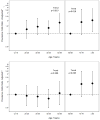Reproductive and hormonal risk factors for antinuclear antibodies (ANA) in a representative sample of U.S. women
- PMID: 25086100
- PMCID: PMC4361940
- DOI: 10.1158/1055-9965.EPI-14-0429
Reproductive and hormonal risk factors for antinuclear antibodies (ANA) in a representative sample of U.S. women
Abstract
Background: Autoantibodies are of growing interest in cancer research as potential biomarkers; yet, the determinants of autoimmunity are not well understood. Antinuclear antibodies (ANA) are common in the general population and are more prevalent in women and older adults. Here, we examined the relationship of ANA with reproductive and hormonal factors in a representative sample of U.S. women.
Methods: We analyzed data on reproductive history and exogenous hormone use in relation to serum ANA in 2,037 females ages 12 years and older from the National Health and Nutrition Examination Survey (NHANES; 1999-2004). Estimated ANA prevalences were adjusted for sampling weights. Prevalence ORs (POR) and 95% confidence intervals (CI) were adjusted for age, race, and poverty-income ratio, and models were stratified by menopause status.
Results: In premenopausal women ages 20 years and older, ANA prevalence was associated with parity (P < 0.001; parous vs. nulliparous POR = 2.0; 95% CI, 1.2-3.4), but in parous women, ANA did not vary by number of births, age at first birth, years since last birth, or breastfeeding. In postmenopausal women, ANA prevalence was associated with an older age at menarche (P = 0.019; age 16-20 vs. 10-12 years POR = 3.0; 95% CI, 1.6-5.9), but not with parity. Oral contraceptives and estrogen therapy were not associated with a higher ANA prevalence.
Conclusions: Childbearing (having had one or more births) may explain age-associated elevations in ANA prevalence seen in premenopausal women.
Impact: These findings highlight the importance of considering reproductive history in studies of autoimmunity and cancer in women.
©2014 American Association for Cancer Research.
Conflict of interest statement
The authors have no conflicts of interest to disclose.
Figures


References
-
- Zaenker P, Ziman MR. Serologic autoantibodies as diagnostic cancer biomarkers--a review. Cancer Epidemiol Biomarkers Prev. 2013;22:2161–81. - PubMed
-
- Hanash S. Harnessing the immune response for cancer detection. Cancer Epidemiol Biomarkers Prev. 2011;20:569–70. - PubMed
-
- Hanash SM, Baik CS, Kallioniemi O. Emerging molecular biomarkers--blood-based strategies to detect and monitor cancer. Nat Rev Clin Oncol. 2011;8:142–50. - PubMed
Publication types
MeSH terms
Substances
Grants and funding
LinkOut - more resources
Full Text Sources
Other Literature Sources

